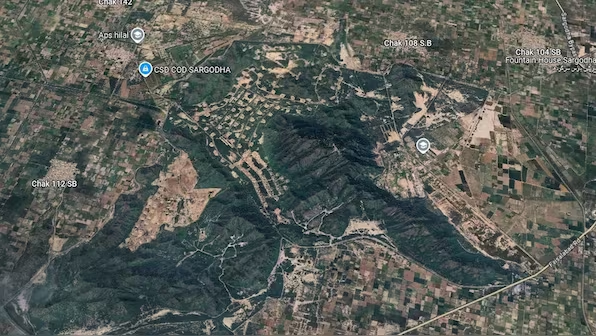New satellite images suggest India may have struck Pakistan’s Kirana Hills during Operation Sindoor. The images, analyzed by geo-intelligence expert Damien Symon, show possible missile impact sites.
This contradicts India’s official denial of targeting the nuclear-linked area.
Operation Sindoor Background
India launched Operation Sindoor on May 9–10, 2025. It was a retaliation for a terror attack in Pahalgam, Jammu and Kashmir.
The attack, linked to Pakistan-backed groups, killed 26 people. Indian Air Force (IAF) conducted precision strikes on Pakistani military targets. These included nine airbases and terror hideouts. The operation aimed to dismantle terror infrastructure.
Kirana Hills’ Strategic Importance
Kirana Hills, in Pakistan’s Sargodha district, is a high-security zone. It is believed to house underground nuclear storage facilities.

Reports suggest it was used for subcritical nuclear tests in the 1980s. The site’s proximity to Mushaf Airbase, just 7 kilometers away, adds to its significance. Reinforced tunnels and radar stations enhance its defenses. Any strike here could signal a major escalation.
India’s Official Denial
Indian officials have denied targeting Kirana Hills. Air Marshal AK Bharti, IAF’s Director General of Air Operations, addressed the rumors on May 12. He sarcastically remarked, “Thank you for telling us Kirana Hills houses nuclear installations.”
Bharti insisted the strikes targeted only terror-related sites. The IAF emphasized precision to avoid nuclear facilities. This was to prevent catastrophic escalation.
Satellite Evidence and Speculation
Google Earth images from June 2025 show damage in Kirana Hills. Symon’s analysis highlights a missile impact site and repaired runways at Sargodha airbase.
Social media posts amplified speculation of a strike on nuclear facilities. Unverified videos showed smoke near the hills, fueling rumors. Some claimed a US B350 AMS aircraft flew over to check for radiation. The International Atomic Energy Agency (IAEA) denied any radiation leaks.
Regional and Global Implications
The alleged strike raises concerns about South Asia’s nuclear stability. Kirana Hills is central to Pakistan’s second-strike capability.
A hit could be seen as a warning from India. It signals India’s ability to target sensitive sites. The US reportedly facilitated a ceasefire after the strikes. This highlights global fears of nuclear escalation. Misinformation on social media adds to the tension.
The recent satellite imagery has stirred significant controversy, challenging India’s narrative about Operation Sindoor.
While the IAF maintains it avoided nuclear sites, the visuals suggest otherwise. Damien Symon’s findings, shared widely on social media , point to a possible missile strike on Kirana Hills. This area, critical to Pakistan’s nuclear program, is heavily fortified with tunnels and radar systems. Its strategic value makes any attack a bold move.
Operation Sindoor was a response to a deadly terror attack in Pahalgam. The IAF’s strikes hit key Pakistani airbases, including Mushaf and Nur Khan. These actions crippled Pakistan’s military infrastructure.
However, the proximity of Mushaf Airbase to Kirana Hills sparked speculation. Social media buzzed with claims of a nuclear facility strike. Videos showing smoke and damaged runways added fuel to the fire. India’s denial came swiftly during a May 12 press briefing. Air Marshal Bharti dismissed the rumors with sarcasm, stressing the strikes targeted terrorists.
The IAF shared evidence of damaged airbases but avoided mentioning Kirana Hills. This strategic ambiguity aimed to de-escalate tensions. The IAEA’s statement, denying radiation leaks, supported India’s claim. Yet, the satellite images tell a different story. The images show a clear impact site in Kirana Hills.

 Trump’s $21M USAID Claim for India Elections Never Existed
Trump’s $21M USAID Claim for India Elections Never Existed  What’s Happening in Iran: India Urges Citizens to Exit
What’s Happening in Iran: India Urges Citizens to Exit  Why Did Bangladesh Choose Mangoes for PM Modi?
Why Did Bangladesh Choose Mangoes for PM Modi?  Pakistan-Russia Freight Train Service to Begin in August 2025
Pakistan-Russia Freight Train Service to Begin in August 2025  Principal Arrested for ‘Period Check’ in Thane School
Principal Arrested for ‘Period Check’ in Thane School  How an Indian Air Force Jaguar Crashed in Rajasthan’s Churu
How an Indian Air Force Jaguar Crashed in Rajasthan’s Churu